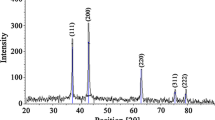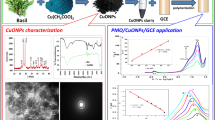Abstract
The authors describe a novel sensor for chlorogenic acid (CGA) detection/quantification in food samples. The photosensor is based on a composite of titanium dioxide (TiO2) and acridine orange (AO). The synergism between AO and TiO2 was revealed under visible LED light irradiation by high photocurrents for CGA, when compared to each component of the composite material. A detection limit of 0.54 μmol L−1 and a linear response range from 2 to 200 μmol L−1 for CGA detection were achieved. The selectivity of the sensor was tested by using common interferents on samples containing chlorogenic acid and results suggested that there is no significant interference in the analyte response, indicating a good selectivity. Finally, the photosensor was successfully applied in the determination of CGA in samples of coffee, tea, and apple juice, with recoveries ranging from 100.9 to 102.4%, suggesting a good accuracy for the proposed method.







Similar content being viewed by others
References
Altin İ, Sökmen M, Biyiklioğlu Z (2016) Sol gel synthesis of cobalt doped TiO2 and its dye sensitization for efficient pollutant removal. Mater Sci Semicond Process 45:36–44
Bakar SA, Ribeiro C (2016) Low temperature synthesis of N-doped TiO2 with rice-like morphology through peroxo assisted hydrothermal route: materials characterization and photocatalytic properties. Appl Surf Sci 377:121–133
David IG, Popa DE, Buleandra M, Moldovan Z, Iorgulescu EE, Badea IA (2016) Cheap pencil graphite electrodes for rapid voltammetric determination of chlorogenic acid in dietary supplements. Anal Methods 8:6537–6544
De Lima JP, Azevedo L, Souza NJ, Nunes EE, Vilas Boas EV (2015) First evaluation of the antimutagenic effect of mangaba fruit in vivo and its phenolic profile identification. Food Res Int 75:216–224
Ding L, Ma C, Li L, Zhang L, Yu J (2016) A photoelectrochemical sensor for hydrogen sulfide in cancer cells based on the covalently and in situ grafting of CdS nanoparticles onto TiO nanotubes. Journal of Electroanalytical Chemistry 783:176–181
Fernandes SC, Moccelini SK, Scheeren CW, Migowski P, Dupont J, Heller M, Micke GA, Vieira IC (2009) Biosensor for chlorogenic acid based on an ionic liquid containing iridium nanoparticles and polyphenol oxidase. Talanta 79:222–228
Ganesh I, Gupta AK, Kumar PP, Sekhar PSC, Radha K, Padmanabham G, Sundararajanet G (2012) Preparation and characterization of Ni-doped TiO2 materials for photocurrent and photocatalytic applications. Sci World J 2012:1–16
Gao C, Wang Y, Yuan S, Xue J, Cao B, Yu J (2017) Engineering anatase hierarchically cactus-like TiO2 arrays for photoelectrochemical and visualized sensing platform. Biosens Bioelectron 90:336–342
Gong J, Fang T, Peng D, Li A, Zhang L (2015) A highly sensitive photoelectrochemical detection of perfluorooctanic acid with molecularly imprined polymer-functionalized nanoarchitectured hybrid of AgI–BiOI composite. Biosens Bioelectron 73:256–263
Hun X, Wang S, Wang S, Zhao J, Luo X (2017) A photoelectrochemical sensor for ultrasensitive dopamine detection based on single-layer nanoMoS2 modified gold electrode. Sensors Actuators B Chem 249:83–89
Jauris IM, Fagan SB, Adebayo MA, Machado FM (2016) Adsorption of acridine orange and methylene blue synthetic dyes and anthracene on single wall carbon nanotubes: a first principle approach. Computational Theoretical Chemistry 1076:42–50
Karthikesan K, Pari L, Menon VP (2010) Antihyperlipidemic effect of chlorogenic acid and tetrahydrocurcumin in rats subjected to diabetogenic agents. Chem Biol Interact 188:643–650
Lagutschenkov A, Dopfer O (2011) Infrared spectrum of a protonated fluorescence dye: acridine orange. J Mol Spectrosc 268:66–77
Liu Y, Wang R, Zhu Y, Li R, Zhang J (2015) Photoelectrochemical sensing of catechol based on CdS-DNA-pristine graphene nanocomposite film. Sensors Actuators B Chem 210:355–361
Liu X, Huo X, Liu P, Tang Y, Xu J, Liu X, Zhou Y (2017) Assembly of MoS2 nanosheet-TiO2 nanorod heterostructure as sensor scaffold for photoelectrochemical biosensing. Electrochim Acta 242:327–336
Ma X, Yang H, Xiong H, Li X, Gao J, Gao Y (2016) Electrochemical behavior and determination of chlorogenic acid based on multi-walled carbon nanotubes modified screen-printed electrode. Sensors (Basel) 16:1797
Maegawa Y, Sugino K, Fau-Sakurai H, Sakurai H (2007) Identification of free radical species derived from caffeic acid and related polyphenols. Free Radic Res 41:110–119
Moakhar RS, Goh GKL, Dolati A, Ghorbani M (2017) Sunlight-driven photoelectrochemical sensor for direct determination of hexavalent chromium based on Au decorated rutile TiO2 nanorods. Appl Catal B Environ 201:411–418
Mohammadi N, Adeh NB, Najafi M (2017) A highly defective mesoporous carbon–ionic liquid paste electrode toward the sensitive electrochemical determination of rutin. Anal Methods 9:84–93
Monteiro TO, Yotsumoto-Neto S, Damos FS, Luz RCS (2016) Development of a photoelectrochemical sensor for detection of TBHQ antioxidant based on LiTCNE-TiO2 composite under visible LED light. J Electroanal Chem 774:36–41
Monteiro TO, Tanaka AA, Damos FS, Luz RCS (2017) Photoelectrochemical determination of tert-butylhydroquinone in edible oil samples employing CdSe/ZnS quantum dots and LiTCNE. Food Chem 227:16–21
Rawel HM, Rohn S, Kruse H-P, Kroll J (2002) Structural changes induced in bovine serum albumin by covalent attachment of chlorogenic acid. Food Chem 78:443–455
Ribeiro CM, Miguel EM, Silva JS, Silva CB, Kubota LT, Gonzaga FB, Santos WJR, Lima PR, Goulart MOF (2016) Application of a nanostructured platform and imprinted sol-gel film for determination of chlorogenic acid in food samples. Talanta 156:119–125
Sanz VC, Mena ML, González-Cortés A, Yanez-Sedeno P, Pingarrón JM (2005) Development of a tyrosinase biosensor based on gold nanoparticles-modified glassy carbon electrodes: application to the measurement of a bioelectrochemical polyphenols index in wines. Anal Chim Acta 528:1–8
Šeruga M, Tomac I (2014) Electrochemical behaviour of some chlorogenic acids and their characterization in coffee by square-wave voltammetry. Int J Electrochem Sci 9:6134–6154
Shin HS, Satsu H, Bae M-J, Zhao Z, Ogiwara H, Totsuka M, Shimizu M (2015) Anti-inflammatory effect of chlorogenic acid on the IL-8 production in Caco-2 cells and the dextran sulphate sodium-induced colitis symptoms in C57BL/6 mice. Food Chem 168:167–175
Tang J, Li J, Zhang Y, Kong B, Wang Y, Quan Y, Cheng H, Al-Enizi AM, Gong X, Zheng G (2015) Mesoporous Fe2O3-CdS heterostructures for real-time photoelectrochemical dynamic probing of Cu2+. Anal Chem 87:6703–6708
Tomac I, Šeruga M (2016) Electrochemical properties of chlorogenic acids and determination of their content in coffee using differential pulse voltammetry. Int J Electrochem Sci 11:2854–2876
Tomac I, Šeruga M, Beinrohr E (2017) Characterization of chlorogenic acids in coffee by flow-through chronopotentiometry. Food Anal Methods 10:3924–3933
Upadhyay R, Rao L (2013) An outlook on chlorogenic acids-occurrence, chemistry, technology, and biological activities. Crit Rev Food Sci Nutr 53:968–984
Vasilescu I, Eremia SAV, Penu R, Albu C, Radoi A, Litescu SC, Radu G-L (2015) Disposable dual sensor array for simultaneous determination of chlorogenic acid and caffeine from coffee. RSC Adv 5:261–268
Wang G-L, Jiao H-J, Liu K-L, Wu X-M, Dong Y-M, Li Z-J, Zhang C (2014a) A novel strategy for the construction of photoelectrochemical sensors based on quantum dots and electron acceptor: the case of dopamine detection. Electrochem Commun 41:47–50
Wang L, Ma W, Gan S, Han D, Zhang Q, Niu L (2014b) Engineered photoelectrochemical platform for rational global antioxidant capacity evaluation based on ultrasensitive sulfonated graphene-TiO2 nanohybrid. Anal Chem 86:10171–10178
Wang Y, Gao C, Ge S, Zhang L, Yu J, Yan M (2017) Self-powered sensing platform equipped with Prussian blue electrochromic display driven by photoelectrochemical cell. Biosens Bioelectron 89:728–734
Wu S, Huang H, Shang M, Du C, Wu Y, Song W (2017) High visible light sensitive MoS2 ultrathin nanosheets for photoelectrochemical biosensing. Biosens Bioelectron 92:646–653
Xi Y, Fan X, Zhao H, Li X, Cao J, Jiang W (2017) Postharvest fruit quality and antioxidants of nectarine fruit as influenced by chlorogenic acid. LWT-Food Sci Technol 75:537–544
Xia L, Song J, Xu R, Liu D, Dong B, Xu L, Song H (2014) Zinc oxide inverse opal electrodes modified by glucose oxidase for electrochemical and photoelectrochemical biosensor. Biosens Bioelectron 59:350–357
Yacoubi B, Samet L, Bennaceur J, Lamouchi A, Chtourou R (2015) Properties of transition metal doped-titania electrodes: impact on efficiency of amorphous and nanocrystalline dye-sensitized solar cells. Mater Sci Semicond Process 30:361–367
Yan Y, Liu N, Hou N, Dong L, Li J (2017) Chlorogenic acid inhibits hepatocellular carcinoma in vitro and in vivo. J Nutr Biochem 46:68–73
Yardim Y, Keskin E, Şentürk Z (2013) Voltammetric determination of mixtures of caffeine and chlorogenic acid in beverage samples using a boron-doped diamond electrode. Talanta 116:1010–1017
Zejli H, Cisneros JLHH, Rodriguez IN, Liu B, Temsamani KR, Marty JL (2008) Phenol biosensor based on sonogel-carbon transducer with tyrosinase alumina sol–gel immobilization. Anal Chim Acta 612:198–203
Zhang T, Liu M, Zhang Q, Wang Y, Kong X, Wang L, Zhang Y (2017) Sensitive determination of chlorogenic acid in pharmaceutical products based on the decoration of 3D macroporous carbon with Au nanoparticles via polyoxometalates. Analyst 142:2603–2609
Zhao J, Chen C, Ma W (2005) Photocatalytic degradation of organic pollutants under visible light irradiation. Top Catal 35:269–278
Funding
This work was supported by Fundação de Amparo à Pesquisa do Estado do Maranhão (00155/16; 00927/16; 01194/17), Conselho Nacional de Desenvolvimento Científico e Tecnológico (303525/2016-9; 421139/2016-1; 305680/2015-3; 426337/2016-6), and Instituto Nacional de Ciência e Tecnologia em Bioanalítica (465389/2014-7). The authors gratefully acknowledge the Microscopy Centre/UFMG that provided the images.
Author information
Authors and Affiliations
Corresponding author
Ethics declarations
Conflict of Interest
K.A.P. Sousa declares that she has no conflict of interest. F.M.R. Lima declares that she has no conflict of interest. T.O. Monteiro declares that she has no conflict of interest. S.M. Silva declares that he has no conflict of interest. M.O.F. Goulart declares that she has no conflict of interest. F.S. Damos declares that he has no conflict of interest. R.C.S. Luz declares that she has no conflict of interest.
Ethical Approval
This article does not contain any studies with human participants or animals performed by any of the authors.
Informed Consent
Not applicable.
Rights and permissions
About this article
Cite this article
Sousa, K.A.P., Lima, F.M.R., Monteiro, T.O. et al. Amperometric Photosensor Based on Acridine Orange/TiO2 for Chlorogenic Acid Determination in Food Samples. Food Anal. Methods 11, 2731–2741 (2018). https://doi.org/10.1007/s12161-018-1261-7
Received:
Accepted:
Published:
Issue Date:
DOI: https://doi.org/10.1007/s12161-018-1261-7




